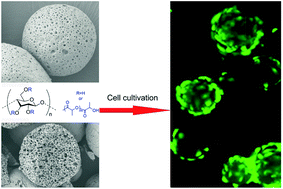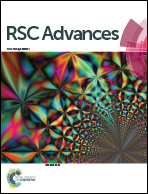Fabrication, hydrolysis and cell cultivation of microspheres from cellulose-graft-poly(l-lactide) copolymers
Abstract
Porous microspheres of cellulose-graft-poly(L-lactide) (cellulose-g-PLLA) copolymers were fabricated by a water/oil/water (W/O/W) emulsion evaporation method. Their morphology, hydrophilicity and amount of hydroxyl group content (–OH content) on the surface were adjustable with the change of molar substitution of PLLA (MSPLLA). After a hydrolysis post-processing, surface physical properties of microspheres were regulated further. The influence of physical properties of microspheres on cell cultivation was investigated by setting hepatocellular liver carcinoma cell line (HepG-2) as the example. Compared with the cells on PLLA microspheres, HepG-2 cells with more pseudopods spread well on the surface of cellulose-g-PLLA microspheres. Particularly, the cellulose-g-PLLA microspheres with MSPLLA of 11.5 were the most appropriate candidate for cell adhesion and proliferation. Therefore, a moderate PLLA content of cellulose-g-PLLA copolymers was beneficial to the cell cultivation. This work indicated that combining cellulose with PLLA was an available route to developing cellulose-based materials for cell cultivation.


 Please wait while we load your content...
Please wait while we load your content...